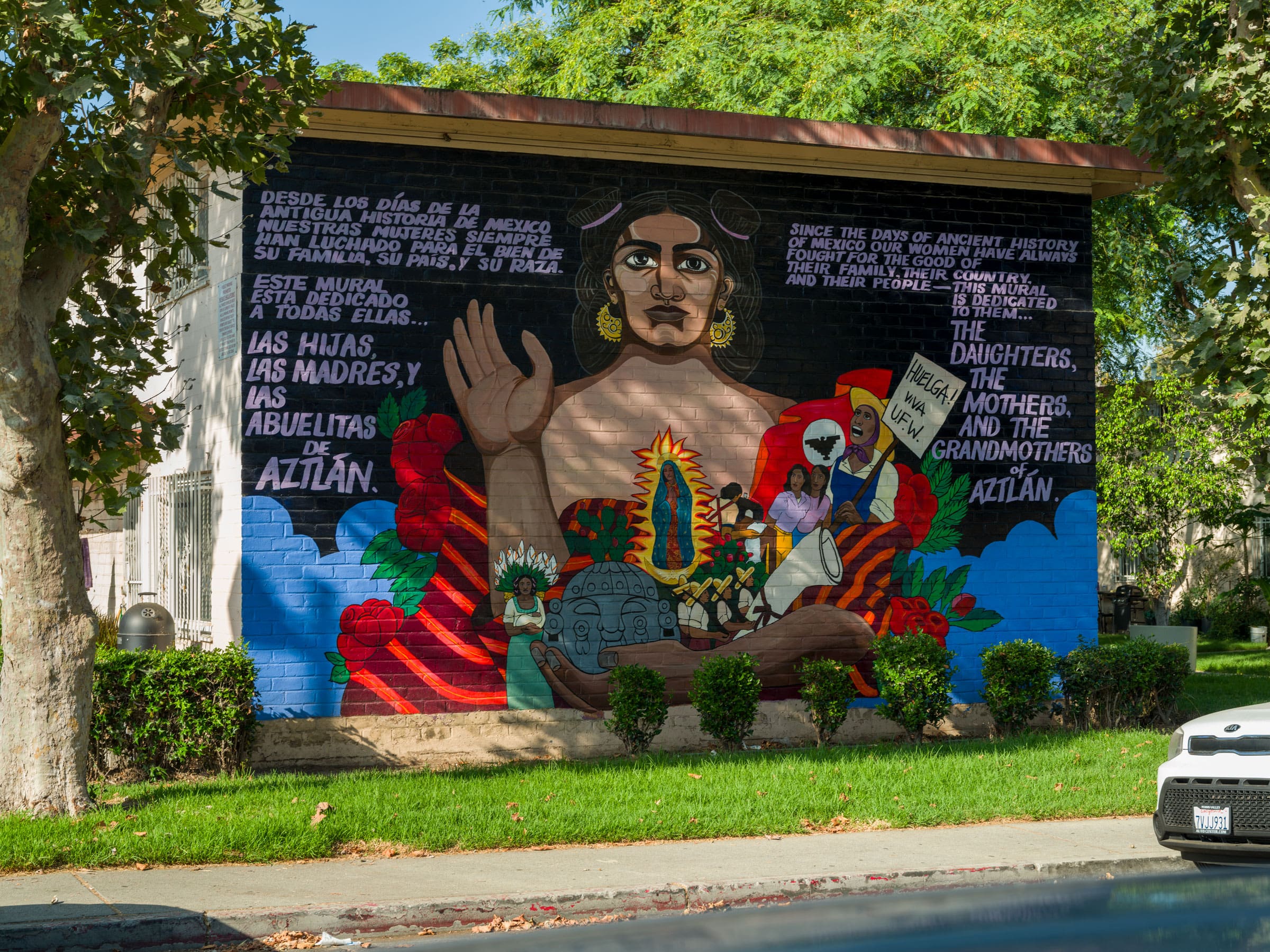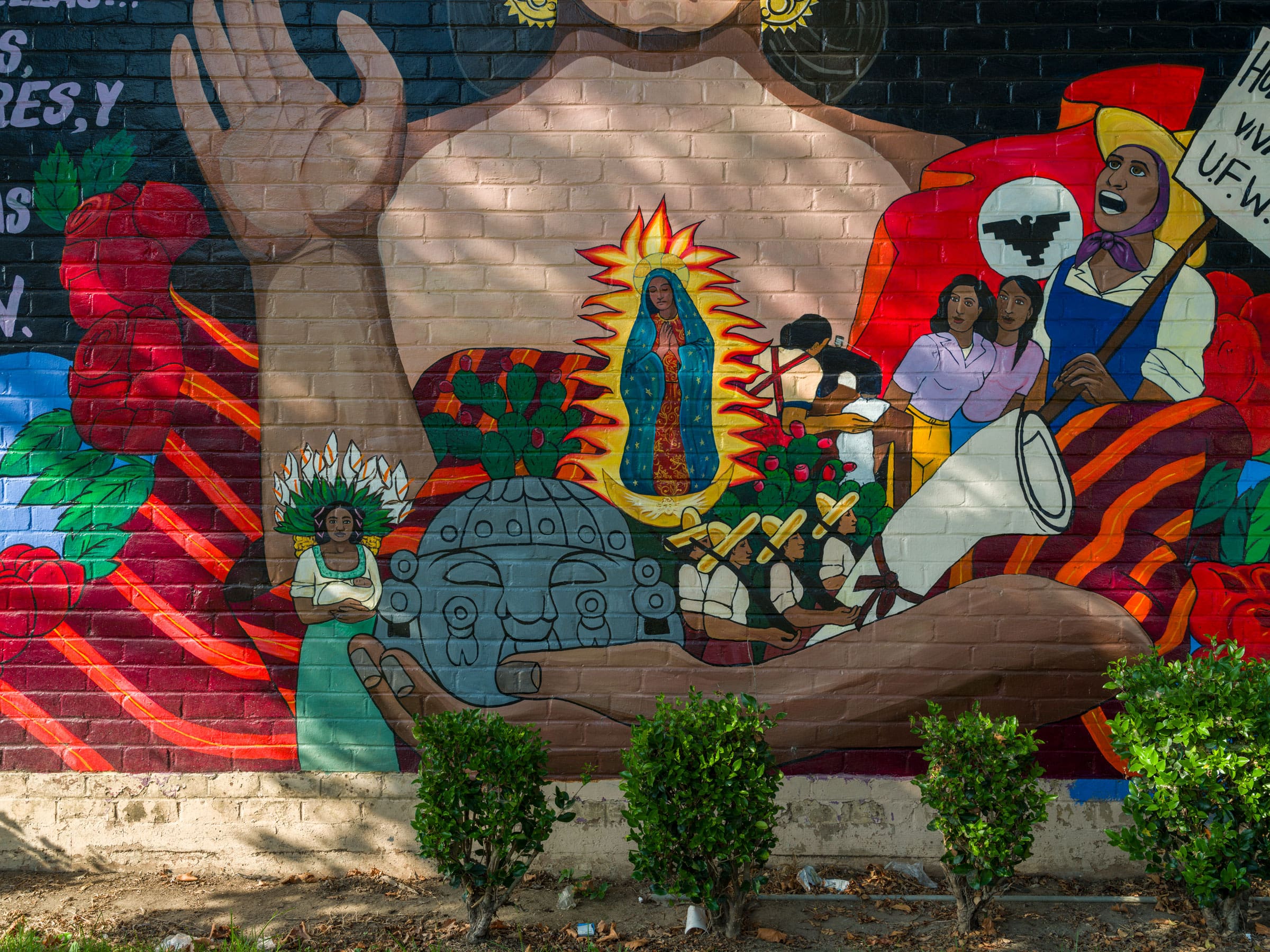OBJECTS
OBJECTOS
JUDITHE HERNÁNDEZ — HOMENAJE A LAS MUJERES DE AZTLÁN , 1976
JUDITHE HERNÁNDEZ — HOMENAJE A LAS MUJERES DE AZTLÁN , 1976
Mural at the Ramona Gardens Housing Project, Los Angeles.
Photo credit: Ruben Diaz
Mural en el Proyecto de Vivienda Ramona Gardens, Los Ángeles (California).
Crédito de foto: Ruben Diaz
The earliest "traditional" mural in this exhibition is
Judithe
Hernández's Homenaje a las Mujeres de Aztlán (1979) at the Ramona
Gardens Housing Project—a public housing development in Boyle Heights
predominantly populated by Mexican and Central American families. Centering a
strong
female archetype, the mural pays homage to the resilience and achievements of
Mexican women throughout time. Adorned with traditional vestments and jewelry,
the
towering figure raises one hand in a gesture of openness and trust while the
other
maternally cradles a host of figures and symbols. This intergenerational
connection
is advanced by the title: Aztlán refers to the mythical homeland of the Aztec
civilization and establishes a matriarchal history of Mesoamerican indigeneity.
The
mural's dedicatory statement, two text panels that flank the composition at
left
and right in Spanish and English, reinforces this theme:
"Since the days of ancient history of México our women have always fought
for
the good of their family, their country, and their people—this mural is
dedicated to them… The daughters, the mothers, and the grandmothers of
Aztlán."
In this ancestral narrative, the matriarch is mestiza—of both indigenous
and
Spanish colonial descent. When muralismo developed in Mexico under
President Álvaro Obregón in the 1920s and 1930s, the government encouraged
muralists
to portray mixed race subjects as a testament to national unity. While this led
to
flattening simplifications of women as an idealized physical type, Hernández
reoriented this trope by celebrating women's ability to encompass multiple
identities. For example, the main figure's hair, styled in two coiled buns,
aligns her with las soldaderas —female revolutionaries who
provided
aid for soldiers and occasionally took up arms in opposition to the dictatorship
during the Mexican Revolution (1910-1920). She also wears gold arracada
earrings, identifiable by their crescent shape. The ubiquitous design dates back
centuries and is a customary gift to young girls on their quinceañera.
At
the same time, she is loosely wrapped in a rebozo —a flat garment
worn
by women that connotes Mexican heritage and pride. During the Mexican
Revolution, it
was instrumentalized by a rebel cohort to carry babies and conceal weapons.
Hernández's matriarch emphasizes how women utilized the physical body,
dress,
and self-presentation as symbols of the ways they were simultaneously displacing
conservative idealizations of Mexican womanhood. In this way, the radical figure
challenges stereotypical behaviors and social constructions engrained by
misogynistic tropes.
The smaller figures and symbols in the woman's arms are no less significant,
each referencing elements of Mexico's matrilineal mythology. The lineage
begins
with Tonantzin (a Nahuatl word meaning "our mother"), who dons a
maize crown and is considered the basis for the Catholicized Virgen de
Guadalupe.
Next, La Virgen appears in her customary blue robe and is engulfed by
otherworldly
light. A head-bust sculpture is wedged between these deities, referencing the
Aztec
goddess Coyolxāuhqui at Coatepec, now housed at the Museo Nacional de
Antropología
in México City. The remaining heroines are workers like agricultural laborers
and a
seamstress. Rounding out the assembly is a striking United Farmer Workers union
member—marked by the union's insignia of the black eagle (another nod
to
the iconography of Aztlán), her overalls, and a picket sign that says:
"Huelga! Viva U.F.W."
El primer mural “tradicional” de esta exposición es el Homenaje a las
Mujeres de
Aztlán (1979) realizado por Judithe Hernández para “The Ramona Gardens
Housing Project” (el Proyecto de Vivienda Ramona Gardens)—un proyecto de
viviendas públicas en Boyle Heights, predominantemente poblado por familias de
México y Centroamérica. Enfocándose en un fuerte arquetipo femenino, el mural
rinde
homenaje a la resiliencia y los logros de las mujeres mexicanas a lo largo del
tiempo. Adornada con vestimentas y joyas tradicionales, la majestuosa figura
levanta
una mano en un gesto de apertura y confianza, mientras la otra sostiene
maternalmente una multiplicidad de figuras y símbolos. Hay una conexión
intergeneracional presentada desde el título: Aztlán se refiere a los
territorios
míticos de la civilización azteca y establece una historia matriarcal de las
comunidades Indígenas Mesoamericanas. La declaración del mural refuerza esta
temática con los dos paneles de texto en inglés y español que flanquean la
composición a izquierda y derecha:
“Desde los días de la antigua historia de México nuestras mujeres siempre han
luchado para el bien de su familia, su país, y su raza. Este mural está dedicado
a
todas ellas… Las hijas, las madres, y las abuelitas de Aztlán.”
En esta narrativa ancestral, la matriarca es mestiza—teniendo ascendencia
indígena y colonial española de manera simultánea. Cuando el muralismo se
desarrolló
en México, durante la presidencia de Álvaro Obregón en las décadas de 1920 y
1930,
el gobierno animó a los muralistas a retratar a personas de raza mixta como
testimonio de la unidad nacional. Si bien esto condujo a simplificaciones
reduccionistas de la mujer como un tipo físico idealizado, Hernández reorientó
esta
figura retórica celebrando la capacidad de las mujeres para abarcar múltiples
identidades. Por ejemplo, el cabello de la figura principal, peinada con dos
moños
enrollados, se encuentra alineadas con las soldaderas—mujeres
revolucionarias
que brindaron ayuda a soldados y ocasionalmente tomaron las armas en oposición a
la
dictadura durante la Revolución Mexicana (1910-1920). La figura también usa
aretes
dorados de arracadas, identificables por su forma de medialuna. El omnipresente
diseño data de siglos atrás y en la actualidad es un regalo habitual para
quinceañeras. Al mismo tiempo, ella se encuentra envuelta holgadamente en un
rebozo,
una prenda de vestir usada por mujeres, denotando herencia y orgullo mexicano.
Durante la Revolución Mexicana, grupos rebeldes los utilizaron para llevar bebés
y
ocultar armas. La figura matriarcal pintada por Hernández enfatiza las maneras
en
que mujeres utilizaron su cuerpo, su vestimenta, y su autopresentación como
símbolos
del desplazamiento del ideal conservador femenino mexicano. De esta manera, la
figura radical desafía comportamientos estereotipados y construcciones sociales
arraigadas en tropos misóginos.
Las figuras y símbolos más pequeños encunados en el brazo de la mujer son
igualmente
significativos, ya que cada uno hace referencia a elementos de la mitología
matrilineal mexicana. El linaje comienza con Tonantzin (palabra Náhuatl que
significa “nuestra madre”), quien porta una corona de maíz y es considerada la
base
de la figura Católica de la Virgen de Guadalupe. A continuación, La Virgen
aparece
con su habitual túnica azul, envuelta por una luz de otro mundo. Un busto
esculpido
está encajada entre las dos deidades, probablemente haciendo referencia a la
diosa
azteca Coyolxāuhqui en Coatepec, que se encuentra ahora en el Museo de
Antropología
en Ciudad de México. Las heroínas restantes son trabajadoras tales como
jornaleras
agrícolas y costureras. Completando la asamblea se encuentra una representante
de la
huelga del sindicato United Farmer Workers—marcada por la insignia
sindical
del águila negra (otra referencia a la iconografía de Aztlán), su overol y un
cartel
que dice: “¡Huelga! Viva UFW.”
+




